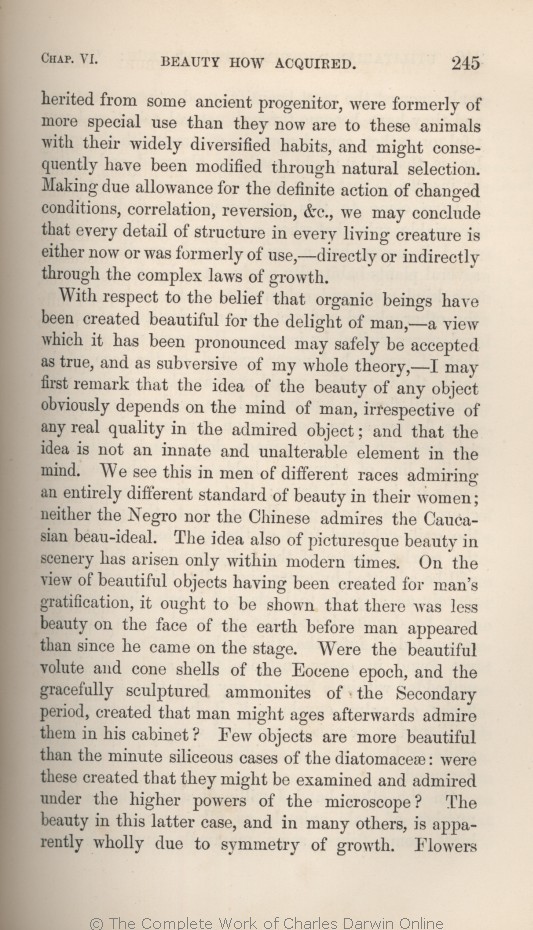of more
special use than they now are to these animals with their widely diversified habits, and might consequently have been modified through natural selection. | special use than they now are to these animals with their widely diversified habits, and might consequently have been modified through natural selection. 1869 |
| special use to that progenitor, or its progenitors, than they now are to these animals having such widely diversified habits. 1859 1860 1861 1866 |
| numerous bones in the fin of some ancient fish-like progenitor of the whole class. 1872 |
| 1 blocks not present in 1859 1860 1861 1866 1869; present in 1872 | | It is scarcely possible to decide how much allowance ought to be made for such causes of change, as the definite action of external conditions, so-called spontaneous variations, and the complex laws of growth; but with these important exceptions, we may conclude that the structure of every living creature either now is, or was formerly, of some direct or indirect use to its possessor.
|
| Making due allowance for the definite action of changed conditions, correlation, reversion, &c., 1869 |
| Therefore 1859 1860 1861 1866 |
| conclude 1869 | | infer 1859 1860 1861 1866 |
| every detail of structure in every living creature is either now or was formerly of use,—directly or indirectly through the complex 1869 |
| these several bones might have been acquired through natural selection, subjected formerly, as now, to the several 1859 1860 1861 1866 |
| growth. 1869 |
| inheritance, reversion, correlation of growth, &c. Hence every detail of structure in every living creature (making some little allowance for the direct action of physical conditions) may be viewed, either as having been of special use to some ancestral form, or as being now of special use to the descendants of this form— either directly, or indirectly through the complex laws of growth. 1859 1860 |
| inheritance, reversion, correlation of growth, &C. Hence every detail of structure in every living creature (making some little allowance for the direct action of physical conditions) may be viewed, either as having been of special use to some ancestral form, or as being now of special use to the descendants of this form— either directly, or indirectly through the complex laws of growth. 1861 |
| inheritance, reversion, correlation of growth, &C. Hence every detail of structure in every living creature (making some little allowance for the direct action of physical conditions) may be viewed, either as having been of special use to some ancestral form, or as being now of special use to the descendants of this form—either directly, or indirectly through the complex laws of growth. 1866 |
|
With respect to the
belief | belief 1869 1872 | | view 1866 |
| man,—a 1866 1869 | | man,— 1872 |
| view 1866 1869 | | a belief 1872 |
| ..... 1869 1872 | | lately 1866 |
| may safely be accepted as true, and as 1866 1869 |
| is 1872 |
| theory,—I 1866 1869 | | theory,— 1872 |
| of any object 1869 |
| of any particular object 1866 |
| OMIT 1872 |
| mind 1866 1869 | | nature 1872 |
| man, 1866 1869 | | the mind, 1872 |
| is not an innate and unalterable element in the mind. 1866 1869 |
| of what is beautiful, is not innate or unalterable. 1872 |
| in 1866 1869 |
| for instance, in the 1872 |
| women; 1866 1869 | | women. 1872 |
| neither 1866 1869 | neither 1872 |
| Negro 1866 1869 | Negro 1872 |
| Chinese 1866 1869 | Chinese 1872 |
| admires 1866 1869 | admires 1872 |
| Caucasian 1866 1869 | Caucasian 1872 |
| beau-ideal. 1866 1869 | beau-ideal. 1872 |
| picturesque beauty in 1869 |
| beauty in natural 1866 |
|









